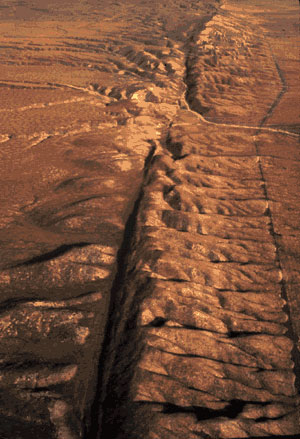Ominous Rumbling Under San Andreas Fault

A continuous shaking from deep in the San Andreas Fault may foretell of future earthquakes, scientists announced today.
The tremors -- not really normal earthquakes, last for more than four minutes. They are "a kind of chatter" coming from depths of 12 to 24 miles below the surface, said Robert Nadeau, from the Berkeley Seismological Laboratory of the University of California.
Over a three-year period, Nadeau and his graduate student, David Dolenc, detected 114 of the events beneath the town of Cholame, CA. These faint rumblings originate up to five times deeper than the average earthquake on this section of the fault.
The geologists have observed a possible correlation between the tremors and the rate of small microquakes in the region.
"This is new information from an area deep down under the fault we have not been able to look at before," Nadeau said. "If these tremors are precursory to earthquakes, there is potential here for earthquake forecasting and prediction."
The town of Cholame is thought to have been the origin of the magnitude 8 Fort Tejon Earthquake of 1857. This was the last big quake to hit southern California, and some seismologists think the area is due for another, since the average time between big quakes is 140 years.
Although the study was no longer running at the time, a moderate, magnitude 6 earthquake erupted on Sept. 28, 2004, outside the city of Parkfield, which is 15 miles northwest of Cholame. Because this quake was near the tremor region, Nadeau believes it supports the tremor-quake relationship.
Get the world’s most fascinating discoveries delivered straight to your inbox.
Map & Photos: USGS
Parkfield describes itself as the "Earthquake Capital of the World" because for 20 years seismologists have been studying the fault-line that cuts through the city. Between the quakes in 1887 and 2004, the area has been hit by five other large events in 1881, 1901, 1922 and 1934.
Earthquake magnitudes are measured with seismographs and rated on the Richter scale:
- 2.5 or less: Usually not felt, but can be recorded by seismograph. 900,000 per year worldwide.
- 2.5 to 5.4: Often felt, but only causes minor damage. 30,000 per year.
- 5.5 to 6.0: Slight damage to buildings and other structures. 500 per year.
- 6.1 to 6.9: May cause a lot of damage in very populated areas. 100 per year.
- 7.0 to 7.9: Major earthquake. Serious damage. 20 per year.
- 8.0 or greater: Great earthquake. Can totally destroy communities near the epicenter. One every 5 to 10 years.
Small tremors have typically been ignored by seismologists, who are more interested in short bursts of activity rather than a sustained rumbling.
But tremors have been observed under volcanoes, and recently led to predictions of the eruption of Mount St. Helens in Washington State. They have also been discovered in Japan and the Pacific Northwest at sites called subduction zones, where one of the Earth's plates dips underneath another.
Nadeau and Dolenc's tremors are the first detected underneath a transform fault, which is where two plates scrape against each other in a horizontal direction. It had been thought that tremors result from fluids flowing deep underground, but Nadeau said that his findings challenge this theory.
"Transform faults like the San Andreas have no obvious source of fluid, so it's not clear what's causing the tremors," he said. "Either tremors don't need fluid, or there is another, unknown source of fluid, perhaps from the Earth's mantle."
By understanding this mechanism better, the researchers hope to uncover whether tremors really can predict earthquakes.
Nadeau and Dolenc describe their work today in the online version of the journal Science.





